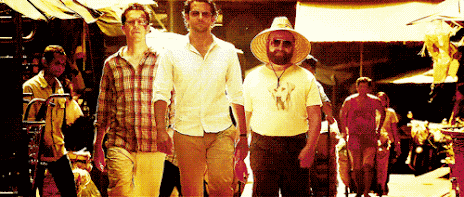"THE HANGOVER, PART II" (2011) Review
Two years after the success of the 2009 blockbuster comedy, "THE HANGOVER", director Todd Phillips followed up with a sequel about the lead characters' adventures in Bangkok, Thailand; following another disastrous bachelor's party. Bradley Cooper, Ed Helms and Zach Galifianakis returned to star in this sequel.
In "THE HANGOVER, PART II", Phil Wenneck, Doug Billings, and Alan Garner accompany Stuart "Stu" Price to Thailand to celebrate his upcoming wedding a woman of Thai descent named Lauren at a beach resort outside of Bangkok. Much to Alan's dismay, Lauren's younger brother, a medical student named Teddy, joins them. Despite disapproval from Lauren's father, who compares Stu to rice porridge, the wedding party goes according to plan. Unfortunately, the four friends and Teddy take part in a mini bachelor's party on the beach. Although Phil insures that the beer they are drinking had not been tampered by the infantile Alan; he, Stu and Alan awaken the following morning at a dirty Bangkok hotel. Apparently, Doug had left the party a little earlier to join his wife at their hotel room. They also discover gangster Leslie Chow (whom they first met in Las Vegas) and a chain-smoking capuchin monkey. Stu has a face tattoo and Alan's head is completely shaven. However, the three friends cannot find Teddy. They only find his severed finger. And as Chow begins recalling the events of the previous night, his heart stops after snorting a line of cocaine. Panicked, the trio dispose of Chow's body in an ice machine and begin their search for the missing Teddy.
In conclusion, I must admit that I found "THE HANGOVER, PART II" very entertaining. One, I loved the Thailand setting and cinematographer Lawrence Sher's photography of the locations. Two, director Todd Phillips did a great job in maintaining the movie's pacing, ensuring that I would never fall asleep. Three, the chemistry between the main cast seemed as potent as ever. I noticed that Phillips continued the chemistry between Cooper, Helms and Galifianakis from the first movie. However, I was a little disappointed that Justin Bartha did not take part in the trio's adventures in this movie. Instead of being the missing person (as he was in the first film), his character left the bachelor party before it all went to hell.
However, Phillips did find a way to bring back Ken Jeong as gangster Leslie Chow. And he was as funny as ever. In fact, one of Jeong's funniest scenes featured the trio and Chow's arrival at a high-class hotel restaurant to meet an American gangster (and undercover Interpol agent) named Kingsley. Other funny scenes include Stu's discovery that he had drug-induced sex with a Kathoey prostitute, Phil's reaction to getting shot by a Russian gangster, Mike Tyson's surprise appearance and performance at Stu and Lauren's wedding, and a crazy car chase through the streets of nighttime Bangkok.
But was "THE HANGOVER, PART II" funnier or just as funny as the 2009 movie? I can honestly say . . . no. The first twenty minutes of the film did not strike me as particularly funny, no matter how much humor Scot Armstrong, Craig Mazin and Todd Phillips tried to wring from the script. The ending seemed a bit too cheesy and sentimental at times. The movie also featured an appearance from Paul Giamatti, who was far from funny in his role as fake gangster/undercover Interpol agent Kingsley. And this was a major disappointment, considering Giamatti's talent for humor. And I wish that Nick Cassavetes' cameo as a Bangkok tattoo artist could have been a bit funny. Instead, I found him a bit overbearing. I suspect that if Mel Gibson had been in the role, he would have garnered a lot more laughs. I could say the same for Mason Lee (Ang Lee's son), who made a less funnier missing person than Bartha. As for Nirut Sirijanya, he seemed downright humorless as Stu's disapproving father-in-law-to-be. I realize that his character was humorless, but so was Melissa, Stu's former girlfriend in the first film. But actress Rachael Harris portrayed the humorless Melissa with a great deal of comedic skill. I cannot say the same for Sirijanya.
Many people had complained that "THE HANGOVER, PART II" more or less followed the same plot formula as "THE HANGOVER". And I agree with them. Like in the first film, the characters experienced the following:
*a hangover from drugs fed to them by the socially challenged Alan
*a missing person who is locked in some space at the hotel they had awaken
*Stu experiences a physical impairment (a tattoo in this film, a missing tooth in the last)
*Stu becomes involved with a prostitute
*theft of someone's pet animal (in this case, a monkey)
*Phil is hospitalized
*a red herring situation regarding the missing person
*Stu sings
*Phil is forced to admit not knowing the location of missing person
*Stu figures out the location of the missing person
Well, you get the drift. The only reason I am willing to tolerate this lack of originality on the screenwriters' parts is due to the fact that I still managed to enjoy the movie. Bradley Cooper, Ed Helms and Zach Galifianakis not only proved that they were still funny, but could also be an effective comedy team. Thanks to the movie's humorous story and performances, and the exotic Thai locations, I still managed to enjoy "THE HANGOVER, PART II".





















